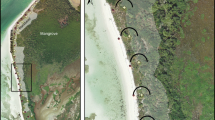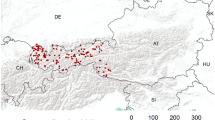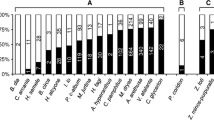Abstract
Butterflies are widely used in biodiversity surveys, and several methods of relative abundance counts have been developed. The most frequently used linear transects are praised for a good replicability, but recently have been criticised for poor species detecting ability, especially for poorly visible or extremely sedentary species. As an alternative, timed surveys, based on zigzagging study sites and flexibly checking transient butterfly resources, have been proposed by some authors. We tested the utility of the two methods while studying the effect of restoration practices on butterfly assemblages in limestone quarries in the Czech Republic. Numbers of species and individuals detected per 10 min transect walk were compared with numbers of species and individuals detected during 10 min timed survey. Mobile and imperceptible species were compared in separate analyses as a measure of detection efficiency. More species and individuals per visit were recorded by timed surveys. No difference in detectability of mobile and imperceptible species between both methods used was observed. Whereas linear transects will probably remain the method of choice for long-term monitoring programs employing armies of recorders, timed surveys appear more appropriate for studies in which it is important to obtain the most comprehensive check-list of species occurring at study sites, which is often the case in conservation inventories in species rich regions with limited number of experienced researchers.

Similar content being viewed by others
References
Bates D, Maechler M (2010). lme4: linear mixed-effects models using S4 classes. R package version 0.999375-35
Benes J, Kepka P, Konvicka M (2003) Limestone quarries as refuges for European xerophilous butterflies. Conserv Biol 17:1058–1069
Benes J, Cizek O, Dovala J, Konvicka M (2006) Intensive game keeping, coppicing and butterflies: the story of Milovicky wood, Czech Republic. For Ecol Manag 237:353–365
Bergman M, Wiklund C (2009) Visual mate detection and mate flight pursuit in relation to sunspot size in a woodland territorial butterfly. Anim Behav 78:17–23
Bink FA (1992) Ecologische atlas van de Dagvlinders van Noordwest-Europa. Schuzt, Haarlem
Bock CE, Bailowitz RA, Danforth DW, Jones ZF, Bock JH (2007) Butterflies and exurban development in southeastern Arizona. Landsc Urban Plann 80:34–44
Collier N, Mackay DA, Benkendorff K, Austin AD, Carthew SM (2006) Butterfly communities in South Australian urban reserves: estimating abundance and diversity using the Pollard walk. Aust Ecol 31:282–290
Cowley MJR, Thomas CD, Roy DB, Wilson RJ, Leon-Cortes JL, Gutierrez D, Bulman CR, Quinn RM, Moss D, Gaston KJ (2001) Density-distribution relationships in British butterflies. I. The effect of mobility and spatial scale. J Anim Ecol 70:410–425
Dennis RLH, Sparks TH, Hardy PB (1999) Bias in butterfly distribution maps: the effects of sampling effort. J Insect Conserv 3:33–42
Dennis RLH, Shreeve TG, Van Dyck H (2003) Towards a functional resource-based concept for habitat: a butterfly biology viewpoint. Oikos 102:417–426
Dennis RLH, Shreeve TG, Isaac NJB, Roy DB, Hardy PB, Fox R, Asher J (2006) The effects of visual apparency on bias in butterfly recording and monitoring. Biol Conserv 128:486–492
Dennis RLH, Hardy PB, Shreeve TG (2008) The importance of resource databanks for conserving insects: a butterfly biology perspective. J Insect Conserv 12:711–719
Harker RJ, Shreeve TG (2008) How accurate are single site transect data for monitoring butterfly trends? Spatial and temporal issues identified in monitoring Lasiommata megera. J Insect Conserv 12:125–133
Huntzinger M (2003) Effects of fire management practices on butterfly diversity in the forested western United States. Biol Conserv 113:1–12
Kadlec T, Benes J, Jarosik V, Konvicka M (2008) Revisiting urban refuges: changes of butterfly and burnet fauna in Prague reserves over three decades. Landsc Urban Plann 85:1–11
Kéry M, Plattner M (2007) Species richness estimation and determinants of species detectability in butterfly monitoring programmes. Ecol Entomol 32:53–61
Konvicka M, Kadlec T (2011) How to increase the value of urban areas for butterfly conservation? Eur J Entomol 108:219–229
Lastuvka Z (1998) Checklist of Lepidoptera of Czech and Slovak Republics. Konvoj, Brno
Marttila O, Saarinen K, Jantunen J (1999) The national butterfly recording scheme in Finland: first seven-year period 1991–1997. Nota Lepidopterol 22:17–34
Pellet J (2008) Seasonal variation in detectability of butterflies surveyed with Pollard walks. J Insect Conserv 12:155–162
Pollard E (1977) A method for assessing changes in the abundance of butterflies. Biol Conserv 12:115–134
Pollard E (1982) Monitoring butterfly abundance in relation to the management of a nature reserve. Biol Conserv 24:317–328
Pollard E, Yates TJ (1993) Monitoring butterflies for ecology and conservation. The British butterfly monitoring scheme. Institute of Terrestrial ecology and joint nature conservation committee. Chapman and Hall, London
R Development Core Team (2009) R: a language and environment for statistical computing. R Foundation for Statistical Computing. Vienna, Austria
Roy DB, Sparks TH (2000) Phenology of British butterflies and climate change. Glob Change Biol 6:407–416
Royer AR, Austin JE, Newton WE (1998) Checklist and “Pollard walk” butterfly survey methods on public lands. Am Midl Nat 140:358–371
Samways MJ (1994) Insect conservation biology. Chapman and Hall, London
Schmitt T (2003) Influence of forest and grassland management on the diversity and conservation of butterflies and burnet moths (Lepidoptera: Papilionoidea, Hesperiidae, Zygaenidae). Anim Biodivers Conserv 26:51–67
Skorka P, Settele J, Woyciechowski M (2007) Effects of management cessation on grassland butterflies in southern Poland. Agric Ecosyst Environ 121:319–324
Spitzer L, Benes J, Dandova J, Jaskova V, Konvicka M (2009) The large blue butterfly, Phengaris [Maculinea] arion, as a conservation umbrella on a landscape scale: the case of the Czech Carpathians. Ecol Indic 9:1053–1056
Stefanescu C, Penuelas J, Filella I (2009) Rapid changes in butterfly communities following the abandonment of grasslands: a case study. Insect Conserv Diver 2:261–269
Steffan-Dewenter I, Tscharntke T (2000) Butterfly community structure in fragmented habitats. Ecol Lett 3:449–456
ter Braak CJF, Smilauer P (2002) CANOCO reference manual and CanoDraw for Windows user’s guide: Software for canonical community ordination (version 4.5). Microcomputer Power, Ithaca
Thomas JA (2005) Monitoring change in the abundance and distribution of insects using butterflies and other indicator groups. Philos Trans R Soc Lond B Biol Sci 360:339–357
Thomas JA, Telfer MG, Roy DB, Preston CD, Greenwood JJD, Asher J, Fox R, Clarke RT, Lawton JH (2004) Comparative losses of British butterflies, birds, and plants and the global extinction crisis. Science 303:1879–1881
Tropek R, Konvicka M (2010) Forest Eternal? Endemic butterflies of the Bamenda Highlands, Cameroon, avoid close-canopy forest. Afr J Ecol 48:428–437
Tropek R, Kadlec T, Karesova P, Spitzer L, Kocarek P, Malenovsky I, Banar P, Tuf IH, Hejda M, Konvicka M (2010) Spontaneous succession in limestone quarries as an effective restoration tool for endangered arthropods and plants. J Appl Ecol 47:139–147
Van Swaay CAM, Nowicki P, Settele J, Van Strien AJ (2008) Butterfly monitoring in Europe: methods, applications and perspectives. Biodivers Conserv 17:3455–3469
Wahlberg N, Klemetti T, Selonen V, Hanski I (2002) Metapopulation structure and movements in five species of checkerspot butterflies. Oecologia 130:33–43
Wenzel M, Schmitt T, Weitzel M, Seitz A (2006) The severe decline of butterflies on western German calcareous grasslands during the last 30 years: a conservation problem. Biol Conserv 128:542–552
Williams MR (2008) Assessing diversity of diurnal Lepidoptera in habitat fragments: testing the efficiency of strip transects. Environ Entom 37:1313–1322
Zonneveld C, Longcore T, Mulder C (2003) Optimal schemes to detect the presence of insect species. Conserv Biol 17:476–487
Acknowledgments
J. Benes contributed by many constructive suggestions and fruitful discussions, Fric and M. Trnik helped us in the field, and S. Polakova and P. Smilauer consulted the statistics. We acknowledge funding from the University of South Bohemia (SGA2008/005), the Czech Science Foundation (206/08/H044, 206/08/H049, P505/10/2167), and the Czech Department of Education (MSM 6007665801, LC06073).
Author information
Authors and Affiliations
Corresponding author
Electronic supplementary material
Below is the link to the electronic supplementary material.
10841_2011_9414_MOESM1_ESM.pdf
List of all detected species, their abbreviations as used in Fig. 1, and affiliation to imperceptible and mobile species guilds. (PDF 8 kb)
Rights and permissions
About this article
Cite this article
Kadlec, T., Tropek, R. & Konvicka, M. Timed surveys and transect walks as comparable methods for monitoring butterflies in small plots. J Insect Conserv 16, 275–280 (2012). https://doi.org/10.1007/s10841-011-9414-7
Received:
Accepted:
Published:
Issue Date:
DOI: https://doi.org/10.1007/s10841-011-9414-7




